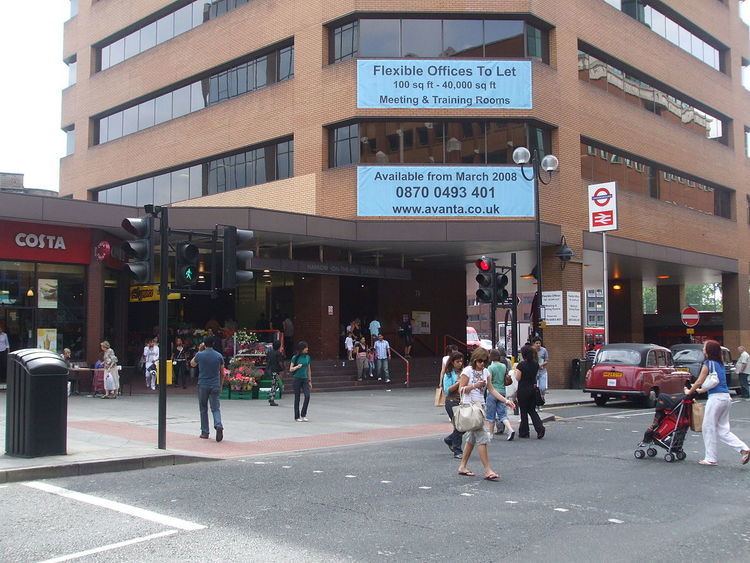Station code HOH 2009 8.59 million Opened 2 August 1880 | Fare zone 5 2012 8.85 million Number of platforms 6 | |
 | ||
Address Station Approach, Harrow HA1 1BB, UK Similar London Underground, Northwick Park tube station, Finchley Road tube station, Moor Park tube station, Preston Road tube station | ||
Harrow-on-the-Hill is a London Underground station served by trains on the Metropolitan Line and National Rail, in Travelcard Zone 5. It is located between College Road and Lowlands Road in the Greenhill area of Harrow, about half a mile north of the locality from which it takes its name. This is where the branch from Uxbridge joins the main line and where fast and slow lines are divided.
Contents
Railway geography
The station is the junction of four LU tracks from Baker Street (paired by direction), two Network Rail tracks from Marylebone, four LU tracks (paired by speed) to Amersham and the double-track LU line to Uxbridge which leaves via a burrowing junction west of the station. Services to Watford leave the "Main Line" to Amersham at Watford south junction (not to be confused with Watford Junction) near Rickmansworth.
London Underground
The London Underground service at Harrow-on-the-Hill is provided by the Metropolitan line. The adjacent Underground stations are ( all stations towards London) Northwick Park, (fast services towards Amersham/Chesham) Moor Park (stopping services towards Watford/Amersham/Chesham) North Harrow and (towards Uxbridge) West Harrow. The Metropolitan line operates a varied pattern of trains and not all trains stop at all stations. "Fast" and "semi-fast" services (now reserved for peak times) do not stop between Harrow-on-the-Hill and Finchley Road. The "Fast" line at stations between Harrow and Wembley Park, and between Harrow and Moor Park have no platforms.
Trains to London go to either Aldgate (12tph) or Baker Street(4tph). All Aldgate trains run via Baker Street. Trains from Amersham (2tph),Chesham (2tph) and Uxbridge (8tph) generally terminate at Aldgate, with a 4tph service from Watford to Baker Street, however during peak hours all trains go to/from all destinations.
History
The station was opened as "Harrow" on 2 August 1880, when the Metropolitan Railway was extended from its previous terminus at Willesden Green. Its name was changed to "Harrow-on-the-Hill" on 1 June 1894. Like a number of other Underground stations the name is an example of marketing rather than precision; in this case the town "proper" of the same name is at the top of Harrow Hill while the station is located in Greenhill to the North of Harrow Hill which has become the main shopping area in this part of the Borough of Harrow.
Had the governors of Harrow School not made objections during the planning stage it is possible that the Metropolitan Railway might have followed a different route taking it closer to the town centre on the hill. The station is at the heart of Metro-land.
National Rail
The National Rail service at Harrow-on-the-Hill is provided by Chiltern Railways. Services operate between Marylebone station and Aylesbury using the separate Network Rail tracks from London to Harrow and sharing London Underground tracks between Harrow and Amersham. Chiltern Railways started operating in 1996 after the privatisation of British Rail and provide two trains per hour between Aylesbury and London via Harrow.
History
This service began as the Great Central Railway (GCR) on 15 March 1899. The GCR ran on the former Great Central Main Line, an intercity trunk route and provided services from Harrow to destinations such as Rugby, Leicester, Nottingham and Manchester. The passenger service north of Aylesbury ceased in 1966 due to the Beeching Axe. There was a goods yard, which closed on 3 April 1967.
Station layout
The station building is above ground with the six platforms in a cutting. Two (on the South side) are used by NR services and the other four by the Metropolitan line; the NR platforms are electrified with the LU system (normal services are operated by diesel trains) and incoming LU trains on some routes can be diverted into them should this be necessary during closures of tracks in the area.
The station has two entrances, one on Station Approach (leading to Lowlands Road and Harrow Hill) and one on College Road (for the adjacent Harrow Bus Station and the main shopping area).
The Station is popular as a through route, as it is possible to walk from one entrance to the other without passing through the ticket barrier.
The present main station building replaced older structures at the London end of the platforms (thus leaving Station Road with no station); it consists of a main circulating area built across all tracks with stairs down to all platforms and both street entrances thus requiring a number of steps to be negotiated by all users. During opening hours it also acts as a public footbridge between Lowlands Road and College Road. A pedestrian tunnel connected all platforms to the adjacent but now closed and semi-derelict Post Office sorting office to enable collection and delivery from trains in earlier years.
Disabled access
The TfL publication "Tube Access Guide" dated July 2006 indicates this station as having "Connection only between fast, semi-fast and "all stations" Metropolitan line services" (NB-without lifts there will only be step-free interchange between Metropolitan line trains travelling in the same direction) and "Entry and exit not accessible" (see station description above). The Lowlands Road entrance (which is also the route to the car park and the car passenger pick up and set down area) has the fewer steps.
Bus Station
There is a bus station located next to the station offering London Buses services right across North London.
